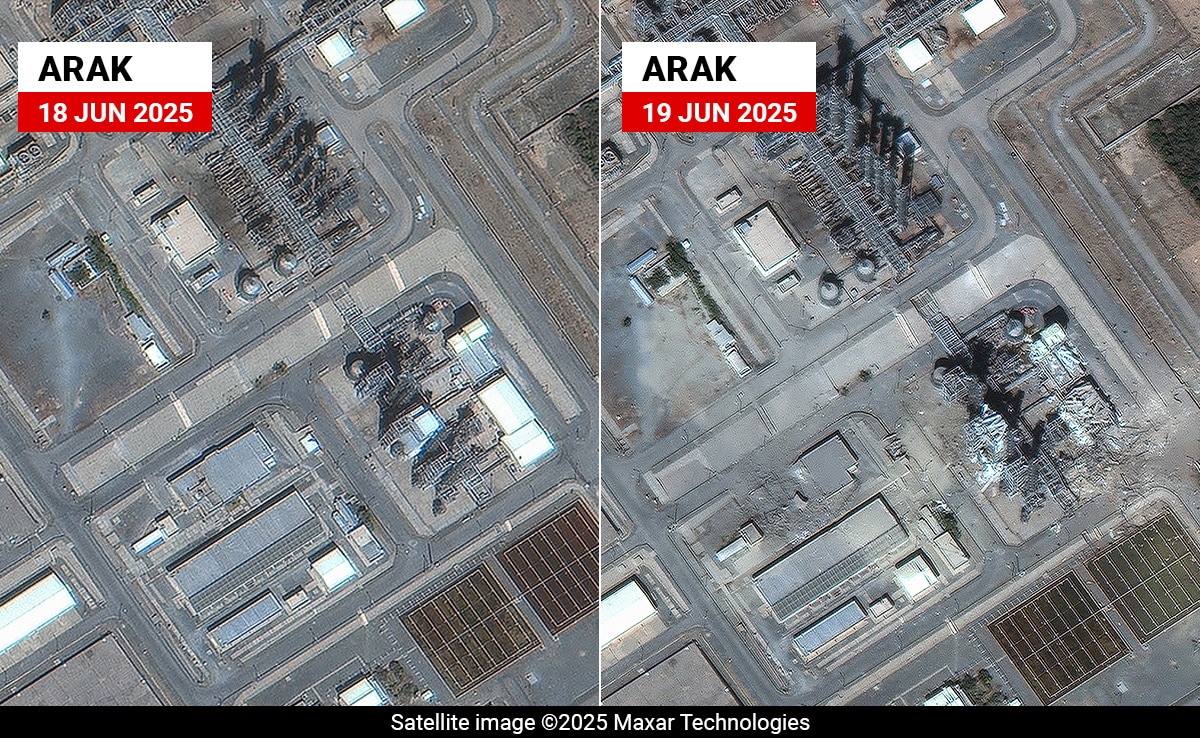- Satellite images confirm Israel's airstrike caused major damage to Iran's Arak reactor facility
- The Arak heavy water reactor can produce plutonium, a potential nuclear weapon material
- Israel targeted the reactor to prevent its restoration for military nuclear use
Satellite pictures from Maxar Technologies, dated June 19, confirm that Israel's recent airstrike caused substantial structural damage to Iran's heavy water reactor facility at Arak, also known as Khondab, roughly 250 kilometres southwest of Tehran. The high-resolution images reveal the collapse of the upper section of the reactor dome alongside visible destruction to adjacent infrastructure, including distillation towers.
While Iranian authorities acknowledged that "projectiles" had struck the compound, they did not initially disclose the extent of the destruction. The satellite images provide the most detailed visual confirmation of the Israeli strike's impact.
Facility Designed For Plutonium Production
Though not operational at the time of the strike, the Arak facility has remained under close observation by nuclear experts due to its technical capacity to produce plutonium, a material that, like highly enriched uranium, can be used to construct a nuclear weapon. Iran has long maintained that its nuclear programme is for peaceful purposes.

Arak was originally conceived in the 1990s following Iran's decision to pursue a nuclear capability in response to the 1980-88 war with Iraq. Unable to procure a heavy water reactor from international sources, Tehran opted to develop its own. According to the Associated Press, heavy water reactors differ from light water reactors in that they use deuterium oxide (heavy water) as a neutron moderator, enabling the use of natural uranium and the production of plutonium as a byproduct.
The Israeli Strikes
Over the past week, Israel has acknowledged strikes on Natanz, Isfahan, Karaj, and Tehran, describing the campaign as a preemptive measure to degrade Iran's nuclear capabilities and prevent any progress toward weaponisation.
Video footage released by the Israel Defense Forces shows precision-guided munitions hitting the reactor dome, followed by a plume of fire and debris. The footage, though brief, was consistent with Maxar's satellite imagery showing the collapse of the reactor dome's crown structure.

In a statement, Israeli officials said the attack was "intended to target the plutonium-producing component of the Khondab reactor in order to prevent its restoration and eventual use for military nuclear development."

The International Atomic Energy Agency (IAEA), the UN's nuclear watchdog, has confirmed that there was no radiological release from the Arak facility, noting that the reactor was not yet loaded with fuel and had never entered operational status. Nevertheless, the agency expressed "serious concern" over the precedent of military attacks on nuclear installations.
Arak's Role In 2015 Nuclear Deal
The Arak reactor was a contentious point during the negotiations of the 2015 Joint Comprehensive Plan of Action (JCPOA), the nuclear deal between Iran and six world powers. As part of that agreement, Iran pledged to redesign the reactor to significantly reduce its plutonium output and render part of the core inoperable by pouring concrete into it.
Yet, following the US withdrawal from the agreement in 2018 under US President Donald Trump, progress on the redesign halted. In 2019, Ali Akbar Salehi, the head of Iran's Atomic Energy Organisation at the time, revealed on Iranian state television that duplicate parts had been secretly procured to allow for the potential reassembly of the disabled components.
Inspectors from the IAEA have repeatedly said since then that due to limitations imposed by Iranian authorities, the agency lost "continuity of knowledge" regarding both the reactor's configuration and heavy water stockpiles.
Track Latest News Live on NDTV.com and get news updates from India and around the world

